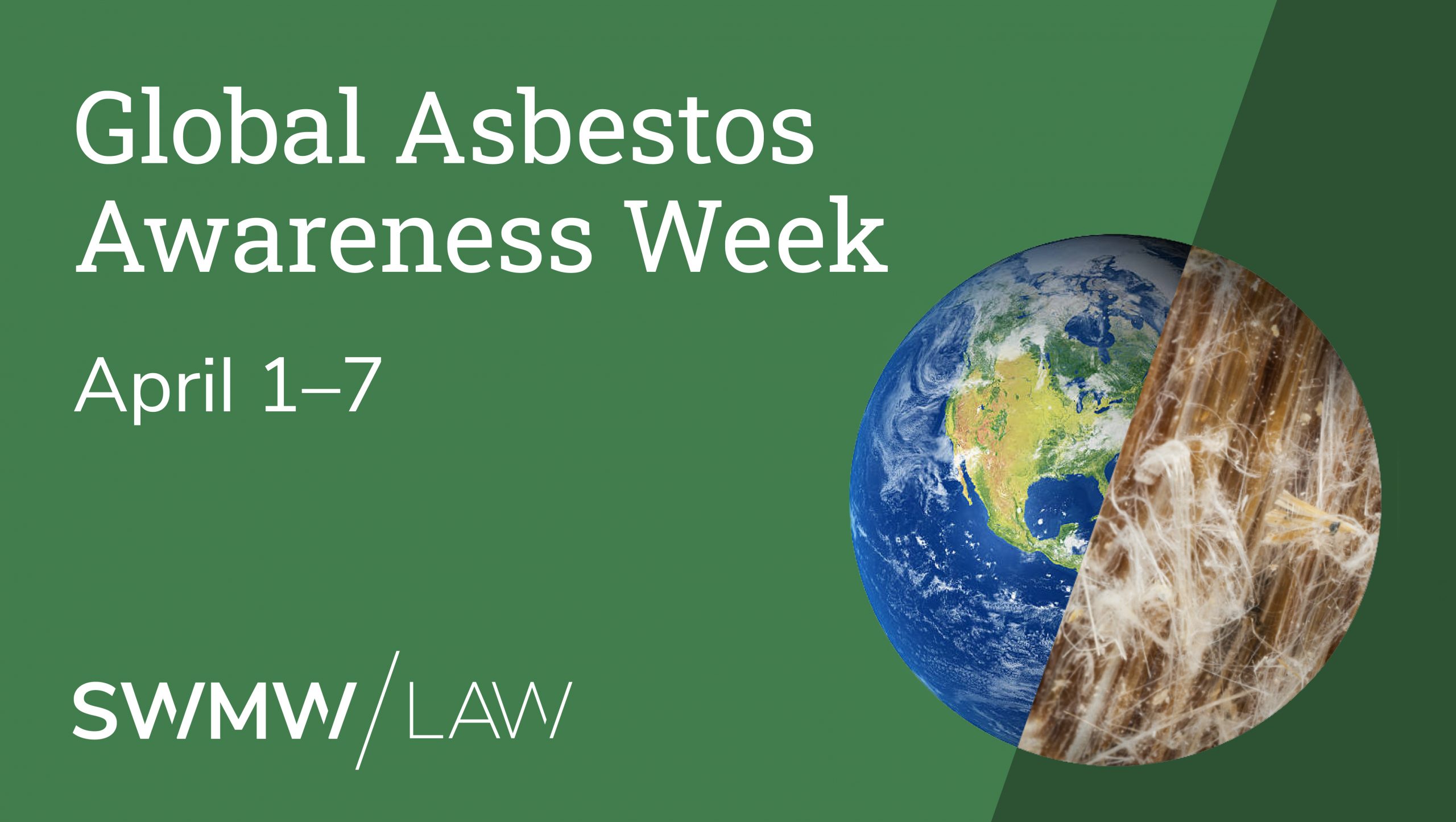For the past 17 years, April 1-7 has been designated Global Asbestos Awareness Week (GAAW), a time to increase awareness of the historic and ongoing dangers of asbestos, preventing future exposure, and advocating for victims around the world. Since 2004, the Asbestos Disease Awareness Organization (ADAO), who first started the observance, has been giving asbestos victims a voice, raising public awareness, and working toward a global asbestos ban, among other education and advocacy work.
Because SWMW Law is dedicated to helping victims of asbestos exposure, we’ll be doing our part to raise awareness with new content every day on our Facebook page.
Why We Need to Raise Awareness about Asbestos
Asbestos is an odorless, tasteless mineral fiber that occurs naturally in rock and soil. For nearly a century, asbestos was used in manufactured goods and building materials across many industries, and was valued for being lightweight, strong, heat-resistant, and inexpensive.
However, when these products are disturbed, whether from cleaning, repair, installation, or removal, millions of undetectable asbestos fibers can be released into the air. When inhaled or swallowed, the fibers can become lodged in the organs and other soft tissues, leading to serious health complications and even death.
Between the 1950s and the 1980s, nearly every home, school, and workplace across every state contained some sort of asbestos material. At highest risk for asbestos exposure are those who have worked with asbestos materials and those who were present on worksites with asbestos materials, along with all their household members.
Mesothelioma and Asbestos Lung Cancer
Despite being a known carcinogen, with definitive evidence that asbestos exposure can cause lung cancer and mesothelioma, the U.S. has failed to impose a full ban of asbestos, putting families and workers at risk to this day. Today, 1.3 million American workers still remain at risk of asbestos exposure and illness. There is no safe exposure level to asbestos.
Asbestos-related lung cancer and mesothelioma are especially aggressive forms of cancer that typically develop years after exposure to asbestos. Unfortunately, there are few treatment options for these types of cancers, and most people diagnosed with mesothelioma and asbestos lung cancer do not survive.
The ADAO cites a Centers for Disease Control and Prevention study that estimates at least 10,000 people die each year from asbestos-related diseases.
The History of Global Asbestos Awareness Week
In 2004, the first Asbestos Awareness Day was observed. Although companies knew of the dangers of asbestos, some as early as the 1930s, general awareness was still lacking, as was accountability. This is due in part to how long it can take between an individual’s first exposure to asbestos and the presentation of disease symptoms. Often, 15 to 50 years can pass before an exposed individual experiences shortness of breath, chest or lower back pain, chronic coughing, difficulty swallowing, or fluid around the lungs. And just as often, these symptoms are diagnosed as something else.
By 2007, members of the asbestos community succeeded in pushing for a week-long awareness event. Their vision was to collaborate with experts and achieve global awareness via in-depth research, education, and conversations with distinguished medical experts and scientists. In order to achieve the much bigger goal of banning asbestos completely, awareness is the crucial first step. Making real and lasting change starts with awareness.
To date, the ADAO has helped pass 16 Asbestos Awareness Week resolutions and enact six U.S. Surgeon General asbestos warnings. Their ongoing advocacy work has brought about HR 1603, the Alan Reinstein Ban Asbestos Now Act, which would “amend the Toxic Substances Control Act to prohibit the import, manufacture, processing, and distribution of asbestos or any mixtures or articles containing asbestos one year after enactment.” The bill passed the House Energy and Commerce Committee in November 2019 and has multiple champions and cosponsors pushing it to a vote on the full House floor.
Raise Awareness with Us this Week
We invite you to follow along with the Global Asbestos Awareness week campaign on the ADAO website. They’re partnering with the Institution of Occupational Safety and Health, Environmental Information Association, and the Mavis Nye Foundation to share expert content on the risks of asbestos, managing asbestos materials safely, and preventing asbestos-related diseases. Along with research and insights, they’ll bring us stories of workers and their families who have been affected by asbestos-related diseases.
The 2021 GAAW’s mission is to “equip people with the tools they need to protect themselves while working for preventative legislation and a cure,” with particular focus on:
- Banning the mining, manufacturing, and use of asbestos
- Preventing asbestos exposure
- Increasing compliance and enforcement of existing laws and regulations
- Strengthening international partnerships
At the end of the week, on April 7, there will be a virtual candlelight vigil to honor and remember those who have battled asbestos-related diseases. Save the date, and join the conversation all week with the hashtag #2021GAAW.


